Many people think they know how to serve caviar. But when you actually get to work, you may find yourself imitating Plato’s immortal words “I know that I know nothing”.
First, you have to buy and store good caviar, which may sound easy but I will soon show you why it isn’t. Then, you must choose the right utensils and accompanying foods and drinks. Intricate rules of eating caviar come next.
But there is no need to fret because you will find the proper methods to serve caviar in this post. Stick around to find out more!

What Is Caviar?
Naturally, you need to know caviar in order to serve it properly. You may or may not know a thing or two about the subject already. But it wouldn’t hurt to refresh your knowledge.
The Nature Of Caviar

To understand what caviar is about, you have to grasp the concept of “roe” or “hard roe”. It is a term meaning the edible, ripe but unfertilized eggs laid by many types of fish and shellfish. “Roe” can be used interchangeably with “fish egg”.
Caviar is made exclusively from the roe of the sturgeon family. There are 27 species of sturgeon in Eurasia and North America, leading to a vast range of caviar. Presently, most caviar for sale comes from farm sturgeons because there aren’t many wild sturgeons left.
Caviar comes in many colors, with the most common ones being black, brown, and amber. Caviar doesn’t have a long shelf life and needs refrigerating all the time. The most important thing about serving caviar is that it must be eaten raw.
Caviar Takes An Incredibly Long Time To Make

Sturgeons need between 8 and 20 years to be sexually mature enough. Just before the eggs are laid, they are extracted from the fish. They then go through the elaborate process of being washed, screened, salted, and tinned.
There is a system of grading in place. High-quality caviar consisting of firm, uniform, and intact beads is grade 1 and is more expensive. Grade 2 caviar has less perfectly formed eggs, so it fetches a lower price.
Grade 2 caviar can be treated with heat. Pasteurization improves caviar’s shelf life but partly mar its texture and flavor. Therefore, unpasteurized caviar is more preferred by food lovers, and it is the type of caviar that I refer to in this post.
How To Store And Chill Caviar Before Serving It

Caviar is usually sold in tins and needs constant refrigeration. An unopened tin of caviar can be stored in the refrigerator for up to 4 weeks. The temperature setting shouldn’t be higher than 5 degrees Celsius.
When a tin of caviar is opened and the content exposed to the air, you should treat it differently. The shelf life is dramatically down to 2 or 3 days. You have to store it at temperatures between 0 degree Celsius and 5 degrees Celsius.
To serve caviar, you have to chill it for a few hours first. Your refrigerator is good enough for this task. But the proper method is to put caviar in a non-metallic bowl and keep it on crushed ice.
Why Do I Have To Keep Metallic Utensils Out?

You’re probably wondering why I emphasize the use of non-metallic bowls. That’s not the whole truth. In fact, the entire set of utensils to serve caviar mustn’t be made from metals.
The reason behind this exclusion is the absorptive quality of caviar. If kept in a metal bowl or spoon, caviar will suck up the metallic taste. This will give you a sharp, acidic, and bitter flavor that will ruin your caviar experience.
Therefore, caviar-serving utensils have to be made from inert materials that don’t react with caviar. Contrary to popular belief, silverware isn’t a good choice because silver can interact chemically with caviar and terribly upset its taste.
The Best Materials For Utensils To Serve Caviar
If something as commonly used as metals is out of the question, what else can you use? Allow me to walk you through all the available alternatives.
Wood/Bamboo
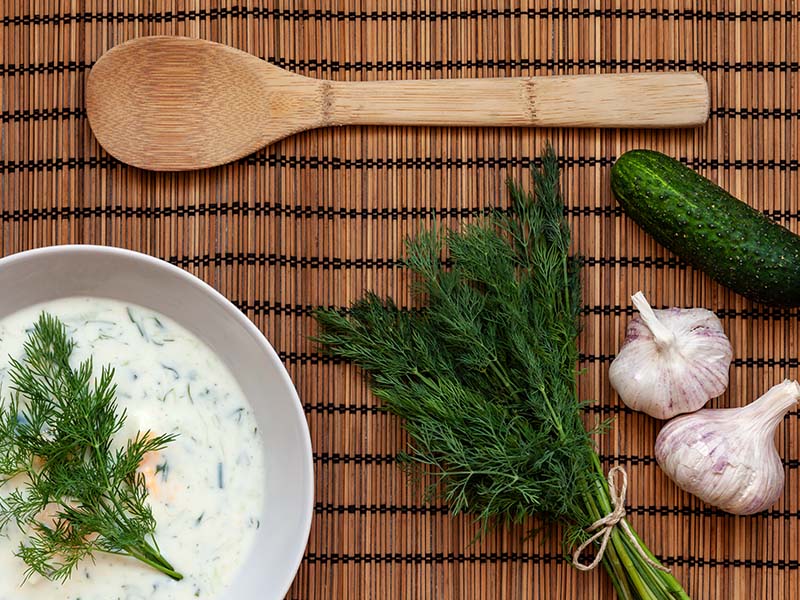
Wooden and bamboo spoons or bowls are inexpensive, easy to find, and lightweight to carry. They also have a nice earthy scent that complements nicely the oceanic aroma of caviar. An extra bonus is that they are very eco-friendly and degradable.
However, this material isn’t easy to keep clean. Neither is it endurable: you can encounter a lot of wear and tear after a short time of use. But that’s where the degradable quality kicks in.
Do you want to save the environment? Follow this guide to make your own bamboo spoons!
Animal Bone/Horn
Bones and horns are great materials for making utensils. They are light, sturdy, and non-reactive. Serving caviar with bone or horn spoons is a delightful and exotic experience.
Such utensils are usually made from the bones and horns of cows or goats. You can also order beautifully handcrafted utensils from Africa. Take care not to buy products coming from endangered species.
Some exotic-looking horn spoons that you can choose.
Plastic

Affordable, flexible, and widely available, plastic utensils are another option to serve caviar. But given the environmental concerns associated with plastic, you may want to switch for something greener.
Besides, plastic certainly cheapens your caviar experience. In 2018, the hotel of the former US President Donald Trump even made the headlines for using plastic spoons to serve caviar (2).
Glass

Glass is a classy option for caviar utensils. A transparent container certainly makes caviar look more appealing from the inside. No wonder why pictures of caviar in glittering glass bowls are all over the Internet.
But glass is heavy and requires constant cleaning to keep it smooth and shiny. You also want to watch your hand: one careless slip and your precious glass spoon is gone.
Porcelain
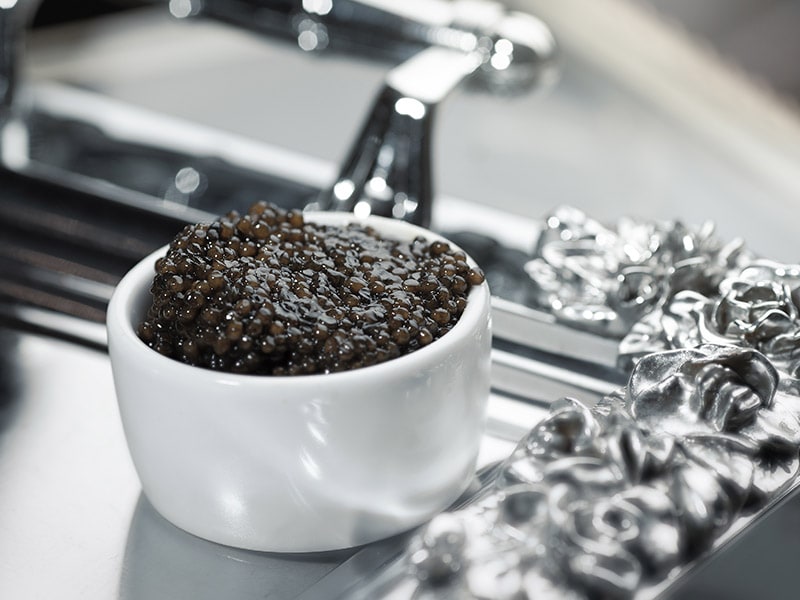
A ceramic caviar spoon enhances the luxurious look of caviar. But it suffers from the same disadvantages of weight and fragility as glass.
Stainless Steel

Though metallic, bowls and spoons made of stainless steel don’t impart the acrid, bitter flavor to the food they hold. Stainless steel is an affordable and easy-to-find material to go with caviar-serving utensils. But it usually gives your party a mundane and unexciting look unless it is made to imitate other materials.
Mother-of-pearl

Back in the days when caviar was for royalty only, mother-of-pearl utensils were the most popular choice. They are beautiful to look at, and the material doesn’t interfere with the flavor of caviar at all. If possible, this should be your first choice.
However, mother-of-pearl is a delicate material. You should take care not to scratch its surface.
Gold

Nothing is a more obvious sign of luxury than a set of gold-plated bowls and spoons. Gold is a non-reactive material so it can go with caviar. Your guests will be awe-struck by this opulent combination.
Caviar Is Best Enjoyed Alone…

While it is OK to pair caviar with other dishes or beverages, you should try it alone. High-end caviar such as beluga or osetra caviar is best served this way. Less expensive varieties can always go with something else.
Caviar can be eaten at any time of the day but it is usually reserved for dinner. At a party, it usually acts as an appetizer. You have to chill caviar with ice until half an hour before serving, so having an ice tray is necessary.
It isn’t elegant to eat a large amount. Don’t eat more than half a spoonful at a time, and no more than 50 grams (about 4 spoonfuls) in all. Overconsumption of caviar will spoil your appetite for the party as well as prevent you from truly appreciating caviar.
The best way to enjoy caviar is to slowly scoop some caviar into your mouth. Caviar is so fine that you only need to move your tongue gently like kissing. The ensuing sensation is as heavenly as any true love’s kiss.
Sit back and let yourself be overwhelmed with the unforgettably rich, buttery flavor. The eggs pop up merrily in your mouth, releasing a pleasant tingling feeling. Long after you’ve swallowed, there’s still a sweet, briny aftertaste left.
… But It Can Go Greatly With Other Stuff
Since you know well how caviar tastes alone, it’s time to try something else. Not everything can pair with this delicate food so I will introduce to you popular options that are best to go with caviar.
Unsalted Bread

The fresh smell, crisp crumbs, and very mild taste of bread do an excellent job of bringing out the rich flavor of caviar. For the best effect, you should use unsalted types of bread. There is enough salt in caviar.
You can go for a baguette, an iconic food from French cuisine. Even a day-old baguette can still complement the flavors of caviar quite well.
Other kinds of food made from flour can fill in the place of bread. You can choose from toasts, crackers, pancakes, or even pasta. If you feel like it, you can put some butter on your bread to improve your appetite.
Blini

Blini is a traditional Slavic pancake and is highly regarded in fascinating Russian cuisine, occasionally baked with cheese and fruit. Many people like to eat caviar the Russian way: put a little caviar on the top of a dollop of blini and enjoy.
Discover how to serve blini with Danish caviar in this video.
Hard-Boiled Eggs

The next best option is right in your refrigerator. You just need to toss some eggs in a well-designed egg cooker, remove the shells, slice each egg in half, spread some caviar on them, and enjoy. Or you can take out the yolks to let the simple taste of the whites enhance your experience.
Are you sure you can cook an egg? Dive in to know the answer.
Sour Cream

Sour cream alone doesn’t go well with caviar, but it can greatly improve the quality of the caviar and bread combination. First, you need to stir sour cream with some herbs like parsley, mint, or dill. Then you top a blini or cracker with this mixture and caviar, and your dish is good to go.
Creme Fraiche
Creme fraiche is a less sour but fattier version of sour cream. It can accompany bread and caviar in the same manner as sour cream. The only difference is that you don’t need to mix creme fraiche with herbs, but rather put a lemon slice on top.
Here is an unexpected way to cook creme fraiche with oysters and chives.
Oysters

If you want to go really wild, raw oysters are the best thing to go with caviar. They are both extremely fresh, salty, and succulent, and the combination of two is overwhelming. People usually say “Opposite attracts” but caviar and oysters prove something else quite, well, opposite.
Drinks To Go With Caviar

The classic beverages to go with caviar are champagne and vodka. A sip of fine wine will make caviar even more attractive.
Still, you would be glad to know caviar can be paired with many other drinks. Choices can range from spirits, whiskey, sake, or even beer, as long as they are of high quality. If you dislike alcohol, bottled water is an acceptable option.
Caviar Vs Fish Roe
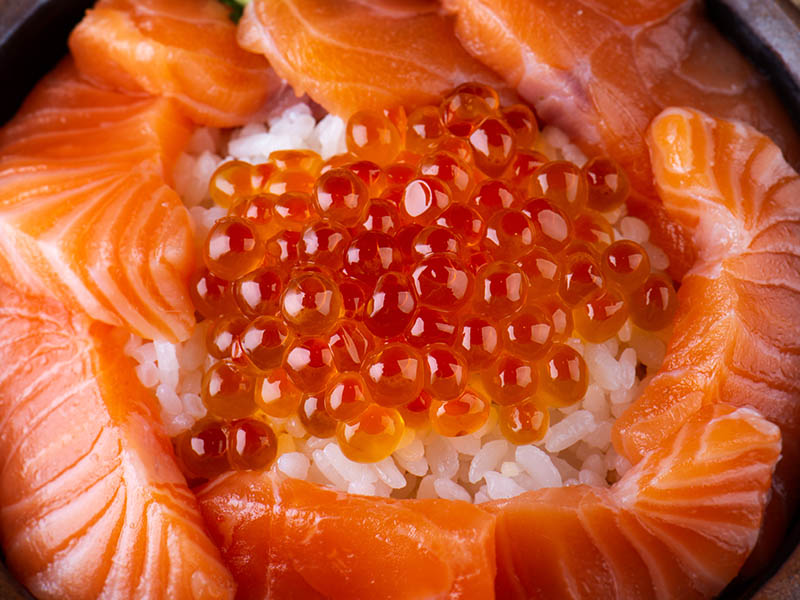
Strolling at any supermarket, you can easily come across shelf after shelf of colorful caviar. But what you see is more likely to be fish roes mislabeled as caviar.
While caviar is a type of fish roe, not all fish roes are fit to be called caviar. Only sturgeon roe-based products are 100% caviar. The problem is that many people use the name “caviar” as a generic term for fish roe.
That’s why you can invariably stumble on non-sturgeon brands like “trout caviar” or “salmon caviar”. There are many differences between caviar and fish roes. For one, all varieties of caviar, even the grade 2 one, are more expensive than fish roes.
In addition, except for the extremely costly white and gold varieties, caviar usually comes in dark colors, such as black, gray, or amber brown. By contrast, most fish roes are vibrantly red, orange, or yellow.
Knowing these things is important. It would be an awkward moment for your party if somebody points out that your “caviar” is in fact fish roes in disguise.
The Best Species Of Caviar To Choose From
Below are some popular types of caviar that should appear at your party.
Beluga Caviar
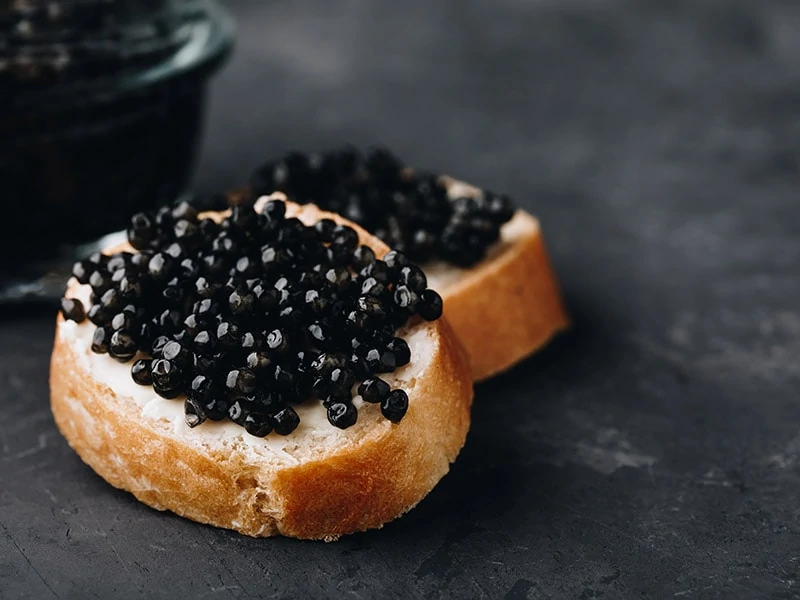
This is the best and costliest variety of caviar. Its mild and delicate taste sets the standard for all other varieties of caviar. It is available in black and gray.
Kaluga Caviar

The Kaluga sturgeon lives in the Amur River and produces eggs that are as excellent as the Caspian beluga sturgeon. The price of this caviar is pretty high but totally worthwhile. Kaluga caviar comes in black, brown, and amber.
Osetra Caviar

It is as good as the beluga variety but a little cheaper. Osetra caviar guarantees you a supreme experience. There are black, gray, amber, and very expensive gold types.
Sevruga Caviar

If you are looking for tasty caviar, the sevruga variety should rank high on your list. Its colors range from black to gray and silver.
Siberian Caviar

This type of caviar is readily available and makes good value for money. It tastes as fatty and earthly as the Russian wilderness where it comes from.
Hackleback Caviar

An American-made product, this type of caviar is relatively more affordable and available. Its fat and nutty eggs are appreciated by many caviar lovers. There are black and dark gray varieties for sale.
White Sturgeon Caviar

Contrary to its name, white sturgeon caviar is black, brown, or amber in color. The richness of its eggs is reminiscent of the vitality of America’s great rivers where the fish comes from.
What Is Good Caviar Like?
In this section, I will identify some characteristics of good and authentic caviar. Basically, you should pay attention to the smell, texture, and taste of your products.
But you should take a good look at the caviar container first. Make sure that you don’t buy dented tins. Also, check the best-by date carefully because caviar doesn’t have a long shelf life.
Smell And Texture

Next, close your eyes, open the can of caviar, and smell the content inside. Good caviar should have an aroma of sea breezes mingled with a very faint scent of fresh fish. There is something fishy about caviar that smells strongly like fish.
Now take a good look at your caviar. Uniformity is what you’re looking for: high-quality caviar should have beads of the same size and color. If the caviar grains come in different sizes and shades of color, your caviar is a subpar sample.
Grade 2 caviar is more likely to fail this test. But while it doesn’t look good, it is still delicious and more importantly less expensive. It’s up to you whether to take the tradeoff or not.
The Taste Of Good Caviar
The last step is to taste your caviar. True caviar must achieve the balance between delicate saltiness and a long-lasting buttery flavor.
Generally, the milder caviar tastes, the more it is appreciated. A rancid, sharply briny taste is a tell-tale sign of bad caviar.
Crisp eggs are another characteristic of good caviar. The eggs should easily burst open when you move your tongue. If they are so hard or elastic that you have to chew them, they are old or fake caviar.
How To Choose Authentic Caviar
When it comes to choosing real and good caviar, misbranded fish roes are the least of your problems. One quick look at the label is enough to get the truth.
But unscrupulous vendors are willing to go to great lengths to deceive you with their fake caviar. I’m going to show you some common tricks and how to see them through.
Fish Roes Dyed Black To Look Like Caviar

Using false labels such as “salmon caviar” or “lumpfish caviar” is a misleading yet still acceptable practice. It is allowed in many countries, provided that caviar producers signify clearly in the label what fish species their products are made from.
But many conveniently forget this and try to hoodwink customers into buying fish roes for the price of caviar. Sadly, the situation is prevalent, especially in the black market.
Scammers can dye ordinary fish roes with black to imitate caviar. In that case, the products will have an overly bright black color with no shades. Another way to test caviar is to put a sample in hot water: dyed fish roes will change the color of water while caviar won’t.
To conceal the smell of fish roes, fake caviar can be infused with higher salt content and artificial flavors. As a result, it will have a stronger, unnatural fish smell and a much brinier taste.
The size of caviar beads is another sign. A sturgeon egg’s size should range from 2.8 to 4.2 mm, no bigger than a pea (1). Some types of fish egg, such as chum salmon roes, can be twice as large.
Gelatin-Based Caviar

Another type of fakery is “caviar” which is made from algae, seaweed, or proteins. Technically, it is called vegan caviar, a cheaper version made for vegetarians who want to eat caviar. It’s also suitable for those who aren’t sure if caviar should be categorized as vegan or vegetarian.
But troubles begin when people pass it off as the real thing. Artificial caviar is essentially a dyed product so you can tell from its appearance the same way I mentioned above. Additionally, fake caviar will soften or dissolve when exposed to hot water.
As for taste, it is easier to detect than non-sturgeon caviar. Having little taste of its own, gelatin-made caviar has to be treated with even more artificial flavors and salt. Therefore, fake caviar has a strongly bitter tang suggestive of chemicals and preservatives.
Some vegan caviar is infused with vegetable oil to give it a fatty taste. Don’t fall for that trick: rub some caviar with your fingers, real caviar never leaves any trail of oil on your skin.
Fruit caviar is a real thing! Check out how to make it from gelatin here.
Mixed-Up Caviar
Low-quality caviar can come in another form. Sometimes, people combine many batches of old and new caviar in various states, re-package, and sell them at a premium price. Also, they can simply charge grade 2 caviar for the price of grade 1 variety.
This type of caviar isn’t exactly fake but it is still a rip-off. You can outwit malicious sellers by looking at their products. Grains of mixed-up caviar come in different shapes, sizes, and colors like a picture of disharmony.
Useful Tips For Caviar Lovers
You are going to find in this section a few great tricks for caviar activities, from buying caviar to putting it on the table.
A Gourmet Store Is Your Best Friend

Caviar is a niche food so common supermarkets or convenience stores aren’t the places to go shopping. Instead, you will find good caviar at gourmet stores that are devoted to fine food. Online stores and websites specializing in caviar are other choices but they make it difficult for you to test your products.
Expensive Doesn’t Mean Better
There are many reasons leading to caviar’s high price, so expensive doesn’t always necessarily mean that it’s of better quality.
So, don’t be afraid to start from the low end of the price range; you may find many pleasant surprises. Advancements in aquafarming help produce better and more affordable caviar. Despite the lack of an outrageous price tag, such caviar can make a delicious dish.
Tasting Is Testing

The best way to evaluate the quality of your caviar is to test it. If a shop doesn’t allow you to do so, you should think about making your purchase somewhere else. In case you make an online order which makes tasting impossible, you should choose a well-known and reliable brand to reduce your risks.
Never Freeze Or Cook Caviar

Caviar can be stored or chilled at 0 degrees Celsius but temperatures below this threshold will destroy its delicate texture and flavor. Also, caviar is always eaten raw. It is a crime to mar the freshness of caviar with heat.
Don’t Chew Or Spread Caviar
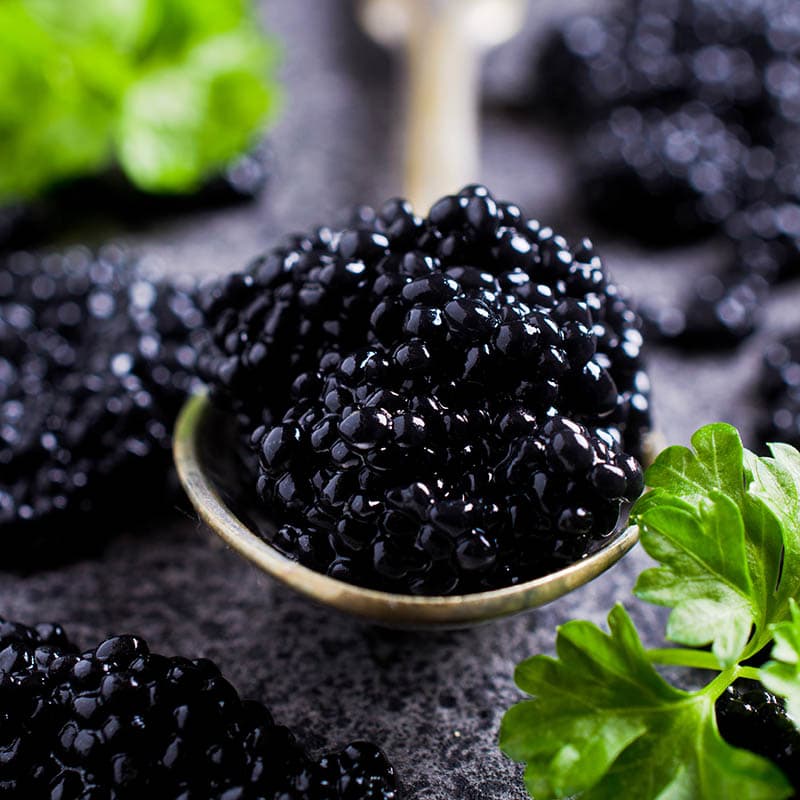
It is a crime to eat caviar with your teeth. Chewing will rob you of the opportunity to truly enjoy the crisp texture and unique flavor of this food. For the same reason, you shouldn’t spread or crush caviar when serving it.
Q&A
Though I hope this post provides you with all you need to learn about how to serve caviar, there are certainly some problems you’re unclear about. Therefore, I’ve included many frequently asked questions to clear your doubts.
It’s Party Time
That’s all I have to share. You now know perfectly well the ins and outs of how to serve caviar properly. Hesitate no more, let’s throw a party and amaze your friends with this luxury food!
You already have the necessary knowledge. It’s time to put it to practice. Invite your friends over now!
Do you find this post useful? If the answer is yes, please share it with your friends and leave your comment. May you have a lively party! Thank you very much.

References
- Edis.ifas.ufl.edu. 2022. Technically Speaking, What Is Sturgeon Caviar?
- Business Insider. 2022. Trump’s Mar-a-Lago is being slammed






